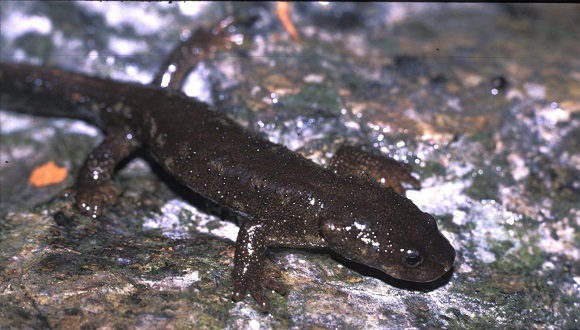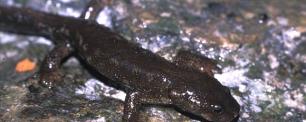Climate change-induced holm oak forest expansion poses a threat to the Montseny brook newt
The future does not look bright for the Montseny brook newt, according to an article published recently in the journal Ecology and Evolution. Led by CREAF and the Spanish National Research Council’s Centre for Advanced Studies in Blanes (CEAB-CSIC), the study on which the article reports concludes that climate change and alterations to vegetation cover in Montseny Natural Park are a threat to the newt’s long-term survival.

The Montseny brook newt is a species of amphibian only found in small streams in the highest parts of the Montseny massif, an area of less than 25 km2 in total, for which reason it is listed as critically endangered by the International Union for Conservation of Nature (UICN). A study led by CREAF researcher Anna Àvila and CEAB-CSIC researcher José L.J. Ledesma, in which Jordi Cunillera, Antonio Barreda-Escoda, Vicenç Altava (all from the Meteorological Service of Catalonia) and Albert Montori (an expert in the biology of the Montseny brook newt) also participated, warns that the spread of Montseny’s woodlands could result in the streams the newts inhabit lacking sufficient water for them for long spells, jeopardizing efforts to reintroduce specimens of the species. If the forest expands, its trees will need more water and there will be a fall in streamflow. The study actually identifies forest growth as the main threat to the newt’s survival, ahead of the warming and low rainfall already being caused by climate change.
Another effect of climate change is that holm oak forests are gradually spreading to increasingly higher altitudes, establishing themselves in areas where heathlands lie and in which they were previously unable to survive, in search of temperatures and humidity levels which suit them better. “This movement will affect the massif’s hydrology and the newt’s aquatic habitats”, states Anna Àvila. Holm oak forest requires more water than heath does, and its trees transpire even in dry periods. Its expansion will therefore increase the ecosystem’s overall evapotranspiration, leaving less water in streams.
The study analysed five years’ worth of flow measurements from a stream in Montseny and their relationship with the climate (precipitation and temperature) and vegetation. Based on that information, the researchers estimated how much water the streams will contain in 2050 and 2100 in different possible climate scenarios. To that end, they took temperature and rainfall predictions and future climate change-induced variations in forest cover into account.
The article’s lead author, José Ledesma, explains that “while the climate and hydrological models and the vegetation cover scenarios entail a degree of uncertainty, all the different scenario combinations indicate that dry periods will occur more frequently and last longer in the future, and that reduces the uncertainty involved and lends weight to our conclusions”.

Too slow to disperse when water is scarce
The Montseny brook newt is almost completely aquatic. It lives, reproduces and feeds in the cold, clean, highly oxygenated waters of the streams that drain Montseny’s beech and holm oak forests. Droughts force them to spend long spells in unfavourable habitat conditions or move away in search of more ideal sites. The newt’s biology is still largely unknown, but studies suggest that it is not highly mobile. Its reduced scope for dispersal and the fact that there are very few streams suitable for the species could lead to a decline in numbers over time, and even extinction in the long term.
Albert Montori, from GRENP (the Parets del Vallès Nature School Research Group), remarks that the Montseny brook newt is much more dependent on aquatic resources than the Pyrenean brook newt. “Unlike the Pyrenean newts, juvenile Montseny brook newts are just as aquatic as adults and larvae, so any drought will affect the entire population”, he says.
Landscape management could help the newt survive climate change
It was not until 2005 that the Montseny brook newt was first formally described as a new species. In 2016, Barcelona Provincial Council secured funding from the EU’s LIFE programme for a project to contribute to the newt’s conservation (the LIFE Tritó Montseny project), the objectives of which are to learn more about the amphibian’s ecology and assess the risks facing it. Successful reintroduction initiatives have doubled the number of individuals in populations, but could ultimately prove to have been in vain if the newt’s habitats cannot be protected. In the words of José Ledesma, “as of now, the most important thing is to quantify and define the newt’s real needs in terms of minimum streamflow and to study its capability to adapt to cope with dry periods”.
Anna Àvila believes that “the study’s results could aid work to manage the conservation of the species, prompting park authorities to carry out forestry activities to avoid holm oak forest expanding in the highest parts of the massif”. Such an expansion is already taking place. A previous study, undertaken by CREAF, shows that holm oak forests have been replacing Montseny’s beech forests and heathlands since the second half of the 20th century. Armed with that knowledge, landscape management geared to controlling forest cover could help guarantee the necessary streamflow and the survival of Montseny’s unique newts.
Article
Ledesma, J.L.J., Montori, A., Altava-Ortiz, V., Barrera-Escoda, A., Cunillera, J., Àvila, A. (2019). Future hydrological constraints of the Montseny brook newt (Calotriton arnoldi) under changing climate and vegetation cover. Ecology and Evolution: early view. doi: 10.1002/ece3.5506
Autor: Àlex Richter-Boix






